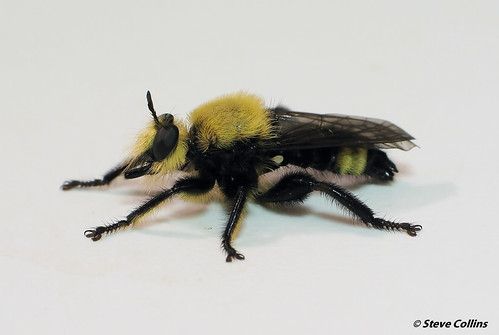boreal laphria
(Laphria posticata)
Conservation • Description • Habitat • Ecology • Distribution • Taxonomy
|
|
||||||||||||||
Description |
Boreal laphria is a small to medium-sized, robust, robber fly. The thorax and abdomen are partially covered with long yellow hairs making it resemble a bumble bee. It is thought to be a mimic of golden northern bumble bee (Bombus fervidus). Adults are ½″ to 11 ⁄16″ long. There are two large compound eyes and three small simple eyes (ocelli). The compound eyes extend above the level of the top of the head (vertex), making the head appear hollowed out between the eyes when viewed from the front. The ocelli are arranged in a triangle on a prominent rounded projection (tubercle) in the middle of the head between the compound eyes. The upper face has long, yellow, erect hairs. There is a cluster of forward-directed bristles (a “beard”) on the lower part of the face. The beard on males is entirely yellow. On females there are yellow hairs at the upper margin of the beard, black hairs below. The hairs below the sucking mouth part (proboscis) are yellow on the male, black on the female. The antennae have 3 segments. The third segment is elongated. The thorax is stout, black, and evenly covered with long yellow hairs. There is a tuft of black hairs in front of the wings and a tuft of mostly yellow hairs with a few black hairs in front of the balancing organs (halteres). The hairs on exoskeletal plate between the abdomen and the thorax (scutellum) are black. On the male, abdominal segment (tergite) 1 is entirely covered with black hairs; tergite 2 has a patch of yellow hairs on the trailing edge (posterior) at each side of the upper surface (dorsolateral); tergite 3 has a similar but larger patch; tergite 4 is completely covered with yellow hairs; tergite 5 is covered by yellow hairs except for the forward (anterior) middle part, which has black hairs; tergites 6 and 7 are entirely covered with black hairs. The female is similar except tergites 1 and 2 are entirely black, and only tergite 3 has yellow dorsolateral patches. The legs are stout and spiny. On the male, the third segment (femur) of the hind leg has a weak line of yellow hairs above (dorsally) and below (ventrally). On the female these are all black. The fourth segment (tibia) of the front and middle legs are covered with long hairs. On the female, these are all black. On the male, the hairs on the front (anterior) side are black, those on the back (posterior) side are yellow. On the female they are all black. The hind tibia of both sexes have all black hairs. The last part of the leg (tarsus), corresponding to the foot, has five segments. The last segment has a pair of claws and 2 pads at the tip. Note: The above description refers to the nominate subspecies L. p. posticata. The other subspecies that may be found in Minnesota is L. p. scutellaris. It has yellow or golden-yellow hairs on the margin of the scutellum and on the upper surface of the hind tibia, and tergite 6 is covered with yellow hairs. |
Size |
Total length: ½″ to 11 ⁄16″ |
Similar Species |
Habitat |
Woodlands and woodland edges |
Ecology |
Season |
June through August |
Behavior |
|
Life Cycle |
|
Larva Food |
|
Adult Food |
Flying insects, including bees, wasps, beetles, and other robber flies |
Distribution |
||
|
Sources |
|
| 6/14/2024 | ||
Occurrence |
||
|
||
Taxonomy |
|
Order |
|
Suborder |
Brachycera |
Infraorder |
Orthorrhapha |
Superfamily |
Asiloidea |
Family |
|
Subfamily |
Laphriinae |
Tribe |
Laphriini |
Genus |
|
Subordinate Taxa |
|
A subspecies has been described that has yellow or golden-yellow hairs on the margin of the scutellum and on the upper surface of the hind tibia, and tergite 6 is covered with yellow hairs. Most sources do not recognize any subspecies. |
|
boreal laphria (Laphria posticata posticata) boreal laphria (Laphria posticata scutellaris) |
|
Synonyms |
|
Bombomima brunnea Bombomima scutellaris |
|
Common Names |
|
boreal laphria |
|
Glossary
Femur
On insects and arachnids, the third, largest, most robust segment of the leg, coming immediately before the tibia. On humans, the thigh bone.
Halteres
In flies: a pair of knob-like structures on the thorax representing hind wings that are used for balance.
Ocellus
Simple eye; an eye with a single lens. Plural: ocelli.
Proboscis
The protruding, tubular mouthpart of a sucking insect.
Scutellum
The exoskeletal plate covering the rearward (posterior) part of the middle segment of the thorax in some insects. In Coleoptera, Hemiptera, and Homoptera, the dorsal, often triangular plate behind the pronotum and between the bases of the front wings. In Diptera, the exoskeletal plate between the abdomen and the thorax.
Tergite
The upper (dorsal), hardened plate on a segment of the thorax or abdomen of an arthropod. Plural: terga.
Tarsus
On insects, the last two to five subdivisions of the leg, attached to the tibia; the foot. On spiders, the last segment of the leg. Plural: tarsi.
Tibia
The fourth segment of an insect leg, after the femur and before the tarsus (foot). The fifth segment of a spider leg or palp. Plural: tibiae.
vertex
The upper surface of an insect’s head.
Visitor Photos |
||
Share your photo of this insect. |
||
This button not working for you? |
||
Luciearl |
||
 |
|
|
| Robber Fly having a meal |
|
|
MinnesotaSeasons.com Photos |
||
|
||
|
||

Visitor Videos |
||
Share your video of this insect. |
||
This button not working for you? |
||
|
Other Videos |
||
|

Created: 7/9/2018 Last Updated: © MinnesotaSeasons.com. All rights reserved. |




